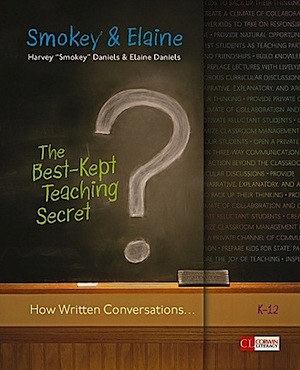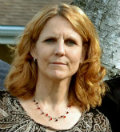The Best Kept Teaching Secret: Written Conversations
The Best Kept Teaching Secret: How Written Conversations Engage Kids, Activate Learning, Grow Fluent Writers (K-12)
by Harvey “Smokey” Daniels & Elaine Daniels
(Corwin Literacy, 2013 – Learn more)
The Best-Kept Teaching Secret by Smokey and Elaine Daniels immediately caught my attention the first time I touched it. This may sound strange, but I love the feel of some books, and this one is beautiful to hold with a creative cover-style.
When I first saw the title I was intrigued. The tagline on the cover continues with How written conversations…engage kids, activate learning, grow fluent writers. Students are naturally social. They love to share and talk. So, when I saw the idea of using “written conversations,” I knew this was a winning combination. Here’s an excerpt from Chapter 1:
….The core idea here is written conversation—a wide variety of letter types including handwritten notes, emails, dialogue journals, write-arounds, silent literature circles, collaborative annotation, threaded discussions, blogs, text messages, tweets, and more. We use these special writing activities to conduct a huge range of learning activities with our students. Year in and year out, the kids tell us this is one of their favorite ways to work, think, and interact with each other.
We know what you’re thinking: “Hmmm, this sounds like a kind of small idea.” Everyone thinks that before they try it. But we’re going to prove to you that letters—very broadly defined—are the single most neglected tool in our teaching repertoires….
Students need to feel connected to classroom activities. The authors used this formula for engagement and created a practical approach that is easy for all teachers to follow.
What’s in the book

- Mini-Memos (Start-up notes, admit notes, writing breaks, and exit notes)
- Dialogue Journals (Paired writing including academic areas)
- Write-Arounds (The groups expands to 3-4 students)
- Digital Discussions (Connecting globally)
Within the sections, you will find structured lessons, detailed applications, and student samples. Lessons are clearly modeled with specifics for all content areas.
One technique I especially liked that would transfer well to my reading groups was “Text on Text.” Students begin with a piece of printed text, especially one that contains contradictory interpretations. After reading the text, students write and annotate in various colors along the margins of the single paper. Students read each other’s comments as the activity continues, causing deeper conversations between them. What a great way for students to demonstrate their thinking processes to each other.
Systematic strategies
When I first glanced at the list of topics I wondered if this was more of the same thing I had been doing in my classes. The topics were similar, but the systematic approach and examples went beyond how I had been using them. Each strategy challenged students to dig deeper into their thinking through written conversations. For teachers, discussions and comments by the authors brought a deeper meaning and understanding to the concepts being presented.
During each lesson, you felt like you were a part of the class, experiencing first-hand how the lesson was implemented. As an added bonus, templates and rubrics are included, saving teacher preparation time. For anyone looking to bring more informal writing with “a purpose” into their classroom, this book is the perfect guidebook.
The book’s narrative and presentation is easy to follow; it’s just like being at a workshop with the authors. I have attended several workshops with Smokey Daniels and the book flows with the same high-energy stories and love for teaching he shares in person.
The Best-Kept Teaching Secret will be a book that I’ll refer to often. The ideas are both powerful and simple to implement, bringing life to written conversations in the classroom. What a great approach for engaging students in something that is a natural part of their lives.
Sandy Wisneski is a lead teacher at Catalyst Charter Middle School, which opened in the fall of 2013. She is the district Webmaster, tech mentor, and yearbook advisor as well as new teacher mentor. Over the past 37 years she has become certified as a Flat Classroom Teacher and obtained her masters in reading. She enjoys challenging students to “take ownership” for their learning and to be effective digital citizens in the world.































